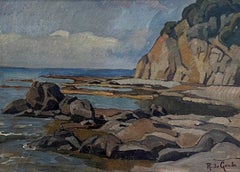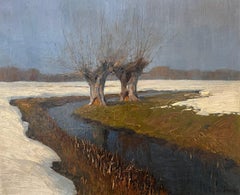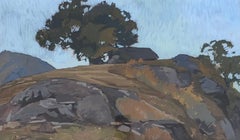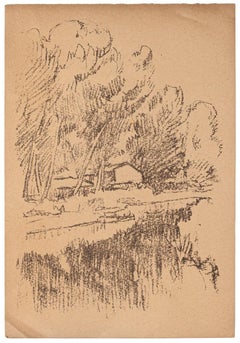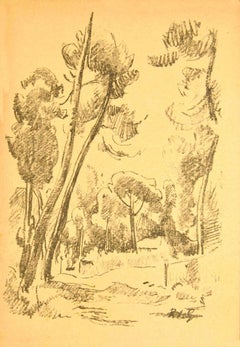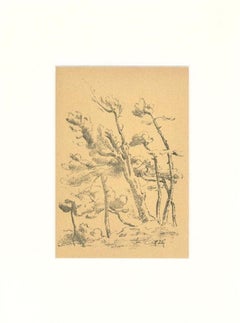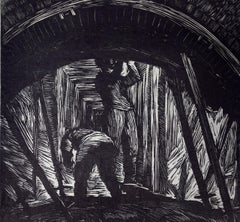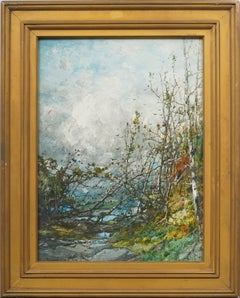Raffaele De Grada Art
Italian, 1885-1957
Initially trained by his father, a decorator, in Argentina and then from 1899 in Zurich, De Grada attended the academies of Dresden and Karlsruhe during the period 1902–05. Influenced by the Swiss secession movement, he enjoyed success as a landscape painter from 1913.
He moved to San Gimignano after World War I, then to Florence, where he lived until 1929. He joined the Novecento Italiano movement and participated in their two exhibitions in Milan (1926 and 1929) as well as their exhibitions collective in other Italian and European cities. His participation in the Venice Biennale began by invitation with the 13th Venice International Art Exhibition in 1922.
After moving to Milan in 1930, he obtained a professorship at the Monza School of Art in 1931. Particularly known for his beautiful views of the Tuscan countryside, De Grada welcomed different generations of artists into his home, including members of the Corrente movement, with whom he also exhibited works in the collective exhibition of the Society of Fine Arts and the Permanent Exhibition in 1939. He participated in numerous exhibitions after the Second World War.
Died in 1957.to
6
6
4
1
1
1
1
Seaside landscape
By Raffaele De Grada
Located in Genève, GE
Work on panel
Beige wooden frame
51.5 x 82.5 x 3 cm
This work of art, entitled "Paysage de bord de mer," captures the raw, untamed beauty of maritime nature with extraordinary precis...
Category
Early 20th Century Italian School Raffaele De Grada Art
Materials
Oil
Landscape in winter
By Raffaele De Grada
Located in Genève, GE
Work on canvas
Black wooden frame with gold borders
66.5 x 77 x 4.3 cm
Category
Early 20th Century Italian School Raffaele De Grada Art
Materials
Oil
Tuscany landscape
By Raffaele De Grada
Located in Genève, GE
Work on paper
Golden wooden frame with glass pane
57 x 79.5 x 4.5 cm
Category
Early 20th Century Modern Raffaele De Grada Art
Materials
Gouache
Landscape - Lithograph by Raffaele De Grada - 1946
By Raffaele De Grada
Located in Roma, IT
Landscape is an original lithograph realized in the 1946 by Raffaele De Grada.
The State of preservation is very good with very small folding along the margi...
Category
1940s Raffaele De Grada Art
Materials
Lithograph
Landscape - Lithograph by Raffaele De Grada - Early 20th Century
By Raffaele De Grada
Located in Roma, IT
Landscape is an original lithograph realized by Raffaele De Grada.
The State of preservation is very good with very small folding along the margins.
Signe o...
Category
Early 20th Century Modern Raffaele De Grada Art
Materials
Lithograph
Landscape - Woodcut by Raffaele De Grada - 1970s
By Raffaele De Grada
Located in Roma, IT
Landscape is an original woodcut realized in the 1970s by Raffaele De Grada
Signed on the lower right.
The State of preservation is very good.
Passepartout...
Category
1970s Raffaele De Grada Art
Materials
Woodcut
Related Items
"Mine Shaft", Soviet Union: An Early 20th C. Woodcut Engraving by Abramovitz
By Albert Abramovitz
Located in Alamo, CA
This is a signed woodcut engraving entitled "Mine Shaft" created by Albert Abramovitz in 1935, after a trip to the Soviet Union. It depicts two Russian workers constructing a mine sh...
Category
1930s Raffaele De Grada Art
Materials
Woodcut
$1,175
H 13.38 in W 8.88 in
Antique American Hudson River School Framed Landscape Signed Original Painting
Located in Buffalo, NY
Antique Hudson River School landscape painting by William Louis Sonntag, Sr. (1822 - 1900). Watercolor and gouache on board. Framed. Signed. Measuring: 13 by 17 inches overall, and ...
Category
1870s Modern Raffaele De Grada Art
Materials
Watercolor, Gouache, Board
$1,475
H 19 in W 25 in D 2 in
Prodigal Son
By Thomas Hart Benton
Located in London, GB
A man raises his hand to his chin, his neck tilted and face turned to look at a dilapidated farmhouse, barely held together by planks of wood and exposed to the elements. Behind him ...
Category
1930s American Modern Raffaele De Grada Art
Materials
Lithograph
Tight Tuck - Surfing Art - Figurative - Woodcut Print By Marc Zimmerman
By Marc Zimmerman
Located in Carmel, CA
Tight Tuck - Surfing Art - Figurative - Woodcut Print By Marc Zimmerman
Limited Edition 01/04
This masterwork is exhibited in the Zimmerman Gallery, Carmel CA.
Immerse yourself in...
Category
2010s Contemporary Raffaele De Grada Art
Materials
Woodcut
Antique Maritime Ships Oil Painting "British Fleet Bay of Naples" Signed & Dated
Located in Portland, OR
An important antique Maritime ships oil on canvas painting of " The British Fleet in the Bay of Naples", by Tommaso De Simone (1805-1888), signed & dated 1860.
The painting depicts t...
Category
1860s Italian School Raffaele De Grada Art
Materials
Oil, Canvas
$18,500
H 25 in W 38 in D 1.75 in
Down the River
By Thomas Hart Benton
Located in London, GB
In this sentimental work from 1939, Benton expresses his admiration for the rural lifestyle of the Midwest. He highlights the connection between man and the land by depicting two fig...
Category
1930s American Modern Raffaele De Grada Art
Materials
Lithograph
Roussillion, Provence. Original Oil landscape, Impressionist, French countryside
Located in Maricopa, AZ
"Roussillion, Provence" by Richard Boyer is an original oil painting, with a dark wood frame and gold accent decorative molding. A picturesque French countryside landscape suited for...
Category
Early 2000s Italian School Raffaele De Grada Art
Materials
Oil
$1,650 Sale Price
25% Off
H 14 in W 18 in
Rainy Market Day, Oil, Italian Tuscan original painting, landscape street scene
Located in Maricopa, AZ
"Rainy Market Day" by Richard Boyer is an original oil painting, with a dark wood frame. Impressionist in style with a European feel.
About the artist:
Richard Boyer’s work is rep...
Category
Early 2000s Italian School Raffaele De Grada Art
Materials
Oil
$1,280 Sale Price
20% Off
H 14 in W 11 in
Ruggero Panerai 19th Century Signed Painting
Located in Roma, IT
An important oil on panel painting by the great Tuscan artist Ruggero Panerai.
It depicts one of his favourite and most successful subjects, wild horses portrayed in a natural pose o...
Category
1890s Italian School Raffaele De Grada Art
Materials
Oil, Wood
Hong Kong urbanscape lithograph
By Ramon Moscardo Fernandez
Located in Barcelona, Barcelona
Josep Moscardó (1953) - Girona Cathedral
Lithograph - Hand signed
Lithograph measures 54x76 cm.
Frameless.
Numbered 12/150
Barcelona, 1953
Painter, sculptor and draftsman of deep-r...
Category
1990s Fauvist Raffaele De Grada Art
Materials
Lithograph
$432 Sale Price
40% Off
H 21.26 in W 29.93 in
Antique American Modernist Nature Study Lake Landscape Framed Oil Painting
Located in Buffalo, NY
Antique American modernist landscape oil painting. Oil on canvas, circa 1940. Signed illegibly lower left. Image size, 36L x 24H. Housed in a period modern frame.
Category
1940s Modern Raffaele De Grada Art
Materials
Canvas, Oil, Gouache
$796 Sale Price
20% Off
H 33 in W 45 in D 2 in
Alfred Bendiner, Santa Fe Cowhands (New Mexico)
By Alfred Bendiner
Located in New York, NY
Apparently Bendiner never went a day without drawing. He was amazing!
In this scene of a young 'cowgirl' is working a lasso while an 'old cowhand' looks on -- clutching a cigaret of...
Category
1950s American Modern Raffaele De Grada Art
Materials
Watercolor
Raffaele De Grada art for sale on 1stDibs.
Find a wide variety of authentic Raffaele De Grada art available for sale on 1stDibs. If you’re browsing the collection of art to introduce a pop of color in a neutral corner of your living room or bedroom, you can find work that includes elements of orange and other colors. You can also browse by medium to find art by Raffaele De Grada in lithograph, gouache, paint and more. Much of the original work by this artist or collective was created during the 20th century and is mostly associated with the modern style. Not every interior allows for large Raffaele De Grada art, so small editions measuring 7 inches across are available. Raffaele De Grada art prices can differ depending upon medium, time period and other attributes. On 1stDibs, the price for these items starts at $223 and tops out at $1,931, while the average work can sell for $251.
